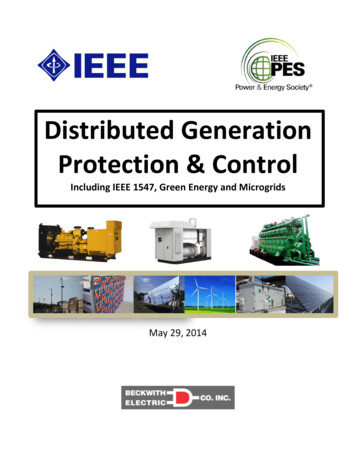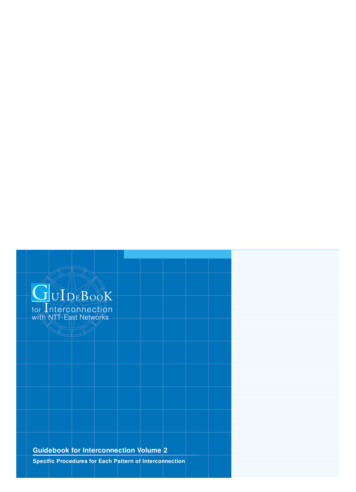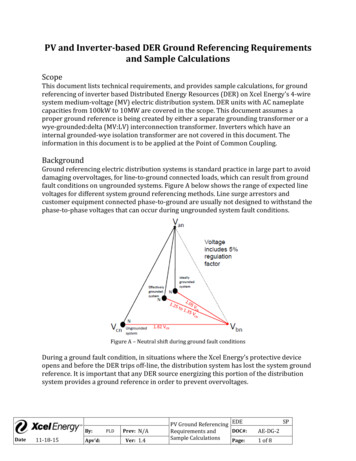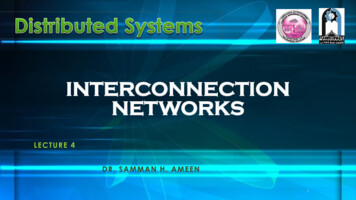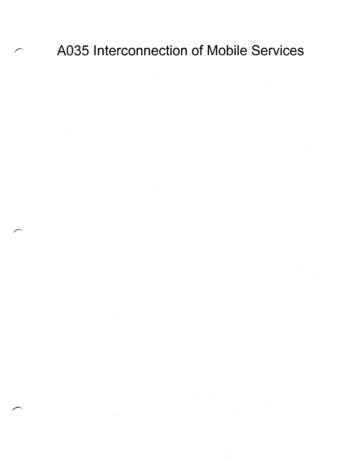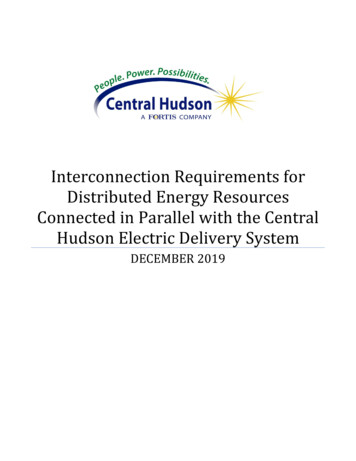
Transcription
Interconnection Requirements forDistributed Energy ResourcesConnected in Parallel with the CentralHudson Electric Delivery SystemDECEMBER 2019
Table of ContentsI. DEFINITIONS. 1II. INTRODUCTION . 4III. APPLICATION PROCESS. 5A. Applications 5 MW . 5B. Applications 5 MW . 5C. NYISO Interconnection Process . 5D. Additional Documentation Required for Detailed Impact Studies. 61. One Line Diagram 72. Description of Operation 73. Site Plan 74. Interconnection Equipment Data Sheets 85. Detailed Specifications of Interconnection Equipment 86. Three Line Diagrams 97. Control Diagrams 98. Written Verification Test Procedure 9E. Project Management . 10F. Service Requirements. 101. Metering Requirements 102. New Service Requirements 11IV. INTERCONNECTION TECHNICAL REQUIREMENTS . 12A. System Design Requirements. 121. General 12a. Standards, Codes, and Guidelines .122. Protection Requirements 13a. Fail Safe and Redundancy (Primary and Backup Systems) .14b. Type Tested and Certified Inverters .14c. Fault Detection on the Central Hudson System .153. Control System Requirements 164. Effectively Grounded Sources 16
a. Purpose of Effective Grounding .16b. Requirements of Effective Grounding .16c. Suggested Effective Grounding Methods .17d. Additional Considerations Specific to Inverter-Based Systems.185. Phase Balancing 196. Power Quality 19a. Voltage Flicker .19b. Harmonic Limits .20c. Limitation of DC Injection .207. Specific Requirements for Induction Generators 208. Specific Requirements for Synchronous Generators 219. Specific Requirements for Inverter-Based DER 21a. General Inverter .21b. Requirements for PV systems .22c. Requirements for Energy Storage Systems .23d. Future Considerations for Smart Inverters .2310. AC Visible Disconnect Switch Requirements 2411. Monitoring & Control 24a. Summary of Requirements.24b. Monitoring Requirements . 25c. Control Requirements .25B. Utility System Modifications and Upgrades. 251. Constraints Requiring Utility Modifications and Upgrades 26a. Thermal Overload.26b. Reverse Power Flow .26c. Operational Contingencies .26d. Distribution Automation .27e. Voltage Regulation .28f. Power Quality .28g. Protection .28(1) Anti-Islanding Protection .28(2) Substation Overvoltage Protection .292. Potential System Upgrades 29a. Distribution.29b. Substation .33c. Transmission .35C. System Testing and Operating Requirements . 361. Preliminary Testing 362. Verification Testing 37a. Minimum Requirements for Verification Testing .37b. Central Hudson Witnessing of Verification Testing.383. Operations, Maintenance, and Future Testing 394. Utility Disconnection of Customer DER System 40V. FUTURE REVISIONS . 42A. NYSSIR. 42
B. NYISO Requirements . 42C. Regulatory Orders . 42D. Industry Standards . 42
FiguresFigure 1- Example of a One-Line Diagram: Three Phase Induction Generator . 43Figure 2- Example of a One-Line Diagram: Three Phase Synchronous Generator . 45Figure 3- Example of a One-Line Diagram: Three Phase Inverter-Based DER System . 47Figure 4- Example of a Three Line Diagram . 48Figure 5- Example of a DC Control Schematic . 49Figure 6- Example of a Functional Test Procedure for the Figure 2 One-Line Diagram . 50Figure 7- Example of a Functional Test Procedure for the Figure 3 One-Line Diagram . 57Figure 8- Examples of Effective Grounding Configurations . 60Figure 9- GE Flicker Curve . 61Figure 10- Example of Required Monitoring and Control for Inverter-Based DER Sites without aPCC Recloser . 62TablesTable 1- Resource Interconnection Study Jurisdiction Table . 63Table 2- Interconnection Equipment Data Sheets . 64Table 3- Identification of “FAIL SAFE” Interconnection Protection Scheme . 67
I. DefinitionsAutomatic Load Transfer (ALT): The automated transfer of load to an alternate electricalsource following an interruption to the main source.Central Hudson Gas & Electric (Central Hudson): The owner of the electric grid to which theDER is connected.Coordinated Electric System Interconnection Review (CESIR): A detailed Impact Study anddetermination of mitigation requirements and cost estimates that may be required as part of theNYSSIR process for DER applications.DER Site: The real property where the DER System is located.DER System: A DER along with all associated equipment that is needed to comply with therequirements in this document, including but not limited to transformers, interrupting devices,protective devices, DER control systems, and utility monitoring and control devices.Direct Transfer Trip (DTT): A scheme to disconnect a DER System from the grid based on acommunications signal from Central Hudson.Distributed Energy Resource (DER): A source of electric power, including distributedgeneration, energy storage technologies, or any combination thereof, that is capable of exportingactive power to the Central Hudson system. For the purposes of this document, DER includessources connected to the distribution system as well as the transmission system, whereapplicable.Distributed Generation (DG): Generation facilities supplementing on-site load, or noncentralized electric power production facilities.Distributed Network Protocol 3 (DNP3): A communications protocol used betweencomponents in process automation systems.Distribution Automation (DA): The process by which data from intelligent electronic devicesis collected, analyzed, and used to control Central Hudson electrical distribution grid functions.Distribution Management System (DMS): A software application which monitors and controlsthe distribution system in conjunction with the system operator.Energy Management System (EMS): A software application which monitors and controls thetransmission system in conjunction with the system operator.Energy Storage System (ESS): A mechanical, electrical, or electrochemical means to storeenergy and release electrical energy, and its associated electrical inversion device and control1
functions, that may be stand-alone or paired with distributed generation at a point of commoncoupling.Federal Energy Regulatory Commission (FERC): The United States federal agency thatregulates the transmission and wholesale sale of electricity in interstate commerce.Impact Study: A study performed by Central Hudson to evaluate the impact of a proposed DERSystem on the safety and reliability of the electric grid and the quality of power delivered tocustomers. This includes preliminary and supplemental screening analysis as well as CESIRsunder the New York State Standardized Interconnection Requirements.Institute for Electrical and Electronics Engineers (IEEE): A technical and professionalorganization that develops standards, guides, and other literature related to, among other topics,the interconnection of DER.Interconnection Customer: the entity with legal authority to enter into agreements regardingthe construction of Distributed Energy Resources, stand-alone Energy Storage Systems, orcombined Distributed Energy Resources and Energy Storage System facilities.Interconnection Online Application Portal (IOAP): Central Hudson’s online DER applicationportal, available from the Central Hudson website.Nationally Recognized Testing Laboratory (NRTL): An independent laboratory recognizedby OSHA to test products to applicable product safety standards.New York Independent System Operator (NYISO): The agency that operates New YorkState's bulk electricity grid, administers New York’s wholesale electricity markets, and providescomprehensive reliability planning for New York’s bulk electricity system.New York State Reliability Council (NYSRC): An entity that develops, maintains, and updatesthe Reliability Rules and Compliance Manual for New York’s Bulk Power System, whichCentral Hudson shall comply with.New York State Standardized Interconnection Requirements (NYSSIR): The New YorkState Standardized Interconnection Requirements for new DER units with a nameplate capacityof 5 MW or less connected in parallel with a utility’s distribution system.North American Electric Reliability Corporation (NERC): A not-for-profit entity organizedunder the New Jersey Nonprofit Corporation Act. NERC’s mission is to assure the effective andefficient reduction of risks to the reliability and security of the Bulk Electric System. NERC isthe FERC designated Electric Reliability Organization (ERO).Northeast Power Coordinating Council (NPCC): A corporation in the state of New Yorkresponsible for promoting and enhancing the reliability of the international, interconnected BulkPower System in Northeastern North America.2
Occupational Safety and Health Administration (OSHA): A government agency that enforcesstandards to ensure safe conditions for working men and women.PCC Recloser: An electronic recloser owned by Central Hudson and located at a DER System’sPCC.Point of Common Coupling (PCC): The point of connection between the DER System and theCentral Hudson system.Point of Interconnection (POI): For the purposes of this document, the point where a DER iselectrically connected in a DER System, excluding any load present in the DER System.Interconnection Customers applying directly to the NYISO shall utilize the NYISO’s definitionof POI.Public Service Commission (PSC): The governing body that regulates the rates and services ofCentral Hudson.Supervisory Control and Data Acquisition (SCADA): The hardware and software thatmonitors and remotely controls equipment on the Central Hudson system.Utility Grade Device: A device that is constructed to comply with, as a minimum, the mostcurrent version of the following standards for non-nuclear facilities:StandardConditions CoveredANSI/IEEE C37.90Usual Service Condition Ratings Current and Voltage Maximum design for allrelay AC and DC auxiliary relays Make and carry ratings for tripping contacts Tripping contacts duty cycle Dielectric tests by manufacturer Dielectric tests by userANSI/IEEE C37.90.1Surge Withstand Capability (SWC) Fast TransientTest IEEE C37.90.2Radio Frequency InterferenceANSI C37.2Electric Power System Device FunctionNumbers IEC 255-21-1VibrationIEC 255-22-2Electrostatic DischargeIEC 255-5Insulation (Impulse Voltage Withstand)Value of DER (VDER): A method of compensating DER projects for electricity provided to thegrid based on application or payment submission date, technology type, interconnection location,and operational characteristics.Verification Test: The final testing of a DER System prior to approval for interconnection. Theverification test shall demonstrate that all protection and control schemes operate as designedunder a variety of grid conditions.3
II. IntroductionThe purpose of this document is to establish the application process and technicalrequirements for the interconnection of non-utility-owned generation and energy storage systemsseeking to operate in parallel with the Central Hudson electrical system. These requirements arenecessary for the safety of the general public and Central Hudson employees, to ensure thatCentral Hudson and its customers’ equipment is protected from damage, and to maintain a highquality of service for all customers.This document does not apply to backup generators using automatic transfer schemes inwhich load is transferred between the generator and Central Hudson in a momentary makebefore-break operation, provided the duration of paralleling the sources is less than 100 ms. Thisdocument also does not apply to electric vehicle installations or systems participating in demandresponse programs.This document does not include requirements for protection of the InterconnectionCustomer’s DER System, as this responsibility is solely the Interconnection Customer’s. Thisdocument also does not include the requirements for microgrid installations or secondarynetwork interconnections.4
III. Application ProcessThere are three different potential application processes for DER systems looking to interconnectto the Central Hudson system. These processes and the criteria determining which of the three aDER developer will follow are outlined below.A. Applications 5 MWFor DER Systems up to 5 MW proposing to operate in parallel within the distribution systemand not participate in NYISO markets, Central Hudson follows the application process as listedwithin the NYSSIR. The steps, timelines, and costs associated within the application process aredictated within the NYSSIR and depend on the characteristics of the DER System including butnot limited to AC nameplate rating, protective equipment, and the existing distribution circuitryat the point of interconnection.Visit the Department of Public Service’s Distributed Generation website for moreinformation and to download the most current version of the NYSSIR. Application informationas well as all applicable forms also can be found on Central Hudson’s Distributed Generationwebsite, along with the ability to submit an application online via Central Hudson’sInterconnection Online Application Portal (IOAP).For questions regarding the interconnection application process, refer to contact informationlisted on Central Hudson’s Distributed Generation website.Note that the NYSSIR application process does not include steps and requirements forcompleting an application to open a new Central Hudson account. If the applicant is not anexisting Central Hudson customer and therefore requires new service for the DER System, referto Section III. F. “Service Requirements.”B. Applications 5 MWDER with an AC nameplate rating greater than 5 MW that do not qualify for the NYISOInterconnection Process will follow the processes and procedures in Section III. A. “Applications 5 MW,” but may be subject to additional state and federal procedures. Note that timelines andcosts may differ from those described in Section III. A. “Applications 5 MW.”C. NYISO Interconnection ProcessFor DER Systems that meet either of the following requirements: Will be connected to a transmission line or transmission substation bus and theInterconnection Customer intends to participate in the NYISO’s wholesale markets,or5
Will be connected to an existing FERC jurisdictional for interconnection distributionbus or circuit and the Interconnection Customer intends to participate in the NYISO’swholesale marketthe Interconnection Customer is required to submit the interconnection request directly to theNYISO. For information on the appropriate NYISO application process, visit the NYISO’swebsite.Table 1 defines the relevant jurisdiction for interconnection study/service based on thejurisdictional principles outlined above.D. Additional Documentation Required for Detailed Impact StudiesThe Interconnection Customer is required to provide supporting data on the proposed DERSystem. This includes all data necessary for Central Hudson to review the installation and todetermine if all interconnection requirements have been met.Equipment shall not be purchased by the Interconnection Customer prior to Central Hudsonreview and approval. This will enable the Interconnection Customer to develop a design that isnot restricted by a previously purchased piece of equipment.The following information is required to allow Central Hudson to adequately review andassess compliance of the Interconnection Customer’s design with Central Hudson’s standards.This information shall be submitted by the Interconnection Customer for Central Hudson’sreview and approval:(1) One Line Diagram(2) Description of Operation(3) Site Plan(4) Interconnection Equipment Data Sheets(5) Detailed Specifications of Interconnection Equipment(6) Three Line Diagrams (AC Relay and Metering Schematics)(7) Control Diagrams (DC Control Schematics and PLC Logic Diagrams / CrossReference Tables)(8) Written Verification Test ProcedureDepending on the complexity of the interconnection, Central Hudson may request additionaldocumentation or clarification from the Interconnection Customer. This information also shall besubmitted and reviewed by Central Hudson before interconnection approval can be granted.6
1. One Line DiagramThe one line diagram describes the interconnection protective system design from theInterconnection Customer’s DER System to the Central Hudson electrical system (typicallythe PCC). The one line diagram should include, as a minimum:(a) A lockable, visible break, load break disconnect switch located within 10 feet of the utilitymeter (if applicable)(b) Transformer size(s), voltages, impedance, and connections(c) Circuit breaker(s), contactor(s), and switch(es) ratings and types(d) Proposed protective function devices identified by ANSI/IEEE Standard C37.2 devicenumbers(e) All interconnection protection function trip and close paths(f) Instrument transformers (voltage and current) voltages, connections, ratios, andnumber(g) Generation source – Type, connections, capacity, and power factor(h) Grounding resistor(s) and/or reactor(s) – Impedance, type, ratings, and calculations (ifapplicable)(i) AC/DC filtering devices – Size, type, ratings(j) All permissive and/or control devices in the trip paths of the interconnectionautomatic isolation devicesFigures 1, 2, and 3 are included as sample one line diagrams. These one linediagrams are provided strictly as examples and do not address the necessary protection forthe Interconnection Customer’s equipment.2. Description of OperationThe Interconnection Customer shall supply a detailed description of the intendedoperation and operational modes of the generation source, including the method of startingand conditions for closing. Any unusual switching procedures or unique operating conditionsalso shall be explained.3. Site PlanThe Interconnection Customer shall submit a detailed site plan showing the following:(a) Point of Interconnection (POI) to the existing Central Hudson circuit(b) Pole layout(c) Equipment layout7
(d) Inverters(e) Step up transformer(s)(f) Grounding transformer(s), if applicable(g) AC disconnect(s)(h) Solar arrays(i) Proposed conductor size and length between the customer-owned step uptransformer and POI4. Interconnection Equipment Data SheetsTechnical data associated with the interconnection system shall be provided toCentral Hudson for review as part of the final design package. This generally includesinformation regarding generators, inverters, transformers, grounding devices, and filteringdevices. Table 2 is included as a sample data sheet which includes information for several ofthese devices.5. Detailed Specifications of Interconnection EquipmentDetailed specifications of the equipment associated with the interconnection systemshall be provided to Central Hudson for review as part of the final design package. Suchinformation should include:(a) Equipment instruction and installation manuals(b) Settings and calculations for all devices, including but not limited to relays,grounding transformers, reactors, and open phase detection equipment(c) SCADA points list and details of communication method for monitoring andcontrol equipment (where required)In selecting protective devices, the Interconnection Customer should keep in mindthat the following requirements should be met:(a) All interconnection protective functions should rely upon non-volatilememory design and include re-settable or retrievable target information.(b) Protective relays and controllers should include AC and DC test switches tofacilitate verification and periodic testing. Current inputs should have shortingtype test switches on either side of each input.(c) All interconnection protective devices should be designed and tested toappropriate industry standards and codes. See Section IV. A. 1. a. “Standards,Codes, and Guidelines” for examples of such standards.8
6. Three Line DiagramsThe Interconnection Customer shall submit all three line diagrams (relay andmetering schematics) of the equipment associated with the interconnection protective system.Three line diagrams should depict all connections (including device terminal numbers),ratings, and sizes of the Interconnection Customer’s:(a) Generator source(s)(b) Instrument transformers (including polarity designations)(c) Transformer(s)(d) Interconnection system automatic disconnect equipment (circuit breakers,contactors and switches)(e) Generator(s) AC control circuitry(f) Interconnection protective devices(g) Test switches for interconnection protective devicesThe Interconnection Customer is reminded that all information depicted on the threeline diagrams shall be accurate and consistent with the design as depicted on the one linediagram. Figure 4 has been included as a sample three line diagram for a small, simpleinstallation.7. Control DiagramsThe Interconnection Customer shall submit all control diagrams (DC controlschematics) of the equipment associated with the interconnection protective system(including device terminal numbers). Control diagrams depict all logic used to control theinterconnection protective devices. If programmable logic controllers are used for thesefunctions, a copy of the ladder logic and reference table(s) shall be included. Figure 5 hasbeen included as a sample control diagram for a small, simple installation.8. Written Verification Test ProcedureThe Interconnection Customer shall submit a verification test procedure as describedin Section IV. C. 2. “Verification Testing” for review and acceptance by Central Hudson.Any additional equipment being used to comply with Central Hudson requirements shall bepart of the verification test procedure. Figures 6 and 7 are included as sample verificationtest procedures.9
E. Project ManagementFor DER Systems that fall under the NYSSIR as described in Section III. A.“Applications 5 MW,” the DER application process is managed through Central Hudson’sElectric Distribution Planning department. Once the Interconnection Customer opts to moveforward with their project by providing upgrade payment(s) related to construction upgrades ornew service, the applicant will be provided with contact information for a Project Manager. Thisis typically done after the completion of engineering studies which identify upgrades and theassociated estimated costs. The Project Manager is the primary resource for providing DERdevelopers with construction status, including any new service work that may be required,answering questions regarding next steps for construction, as well as providing an estimatedconstruction timeline. The Project Manager will remain the liaison between the InterconnectionCustomer and all appropriate areas within Central Hudson who may have a role in theconstruction process. As construction of the DER System nears completion, the Project Managerwill inform the appropriate groups within Central Hudson in order to coordinate the timelycomple
active power to the Central Hudson system. For the purposes of this document, DER includes sources connected to the distribution system as well as the transmission system, where applicable. Distributed Generation (DG): Generation facilities supplementing on-site load, or non-centralized electric power production facilities.

